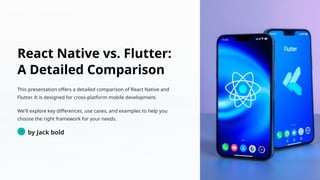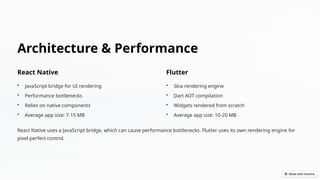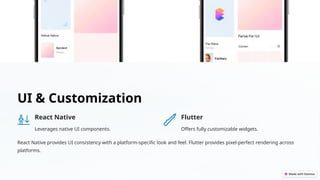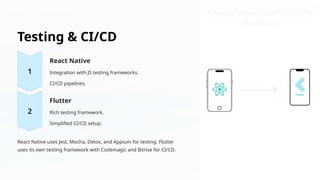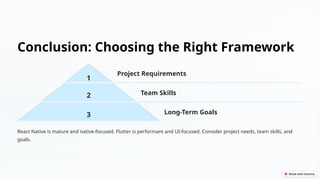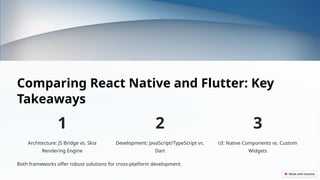React-Native-vs-Flutter-A-Detailed-Comparison.pptx
- 1. React Native vs. Flutter: A Detailed Comparison This presentation offers a detailed comparison of React Native and Flutter. It is designed for cross-platform mobile development. We'll explore key differences, use cases, and examples to help you choose the right framework for your needs. Jb by Jack bold
- 2. Architecture & Performance React Native ŌĆó JavaScript bridge for UI rendering ŌĆó Performance bottlenecks ŌĆó Relies on native components ŌĆó Average app size: 7-15 MB Flutter ŌĆó Skia rendering engine ŌĆó Dart AOT compilation ŌĆó Widgets rendered from scratch ŌĆó Average app size: 10-20 MB React Native uses a JavaScript bridge, which can cause performance bottlenecks. Flutter uses its own rendering engine for pixel-perfect control.
- 3. Development Experience React Native Leverages JavaScript/TypeScript familiarity. Offers hot reloading for faster development. Flutter Uses Dart language, easy for Java/JS devs. Features hot reload & restart for updates. React Native benefits from a large JavaScript ecosystem. Flutter boasts a rich set of pre-designed widgets.
- 4. UI & Customization React Native Leverages native UI components. Flutter Offers fully customizable widgets. React Native provides UI consistency with a platform-specific look and feel. Flutter provides pixel-perfect rendering across platforms.
- 5. Community & Ecosystem 1 React Native Mature community backed by Facebook. Extensive online resources and tutorials. 2 Flutter Growing community backed by Google. Comprehensive documentation. React Native has a vast number of third-party libraries and tools. Flutter has a comprehensive package repository.
- 6. Use Cases & Examples React Native Suited for apps requiring a native look and feel. Ideal for projects leveraging existing JS expertise. Flutter Excellent for visually rich and branded experiences. Great for apps targeting multiple platforms. Examples of React Native apps include Facebook, Instagram, and Skype. Examples of Flutter apps include Google Ads, Alibaba, and BMW.
- 7. Testing & CI/CD React Native Integration with JS testing frameworks. CI/CD pipelines. Flutter Rich testing framework. Simplified CI/CD setup. React Native uses Jest, Mocha, Detox, and Appium for testing. Flutter uses its own testing framework with Codemagic and Bitrise for CI/CD.
- 8. Conclusion: Choosing the Right Framework 1 Project Requirements 2 Team Skills 3 Long-Term Goals React Native is mature and native-focused. Flutter is performant and UI-focused. Consider project needs, team skills, and goals.
- 9. Comparing React Native and Flutter: Key Takeaways 1 Architecture: JS Bridge vs. Skia Rendering Engine 2 Development: JavaScript/TypeScript vs. Dart 3 UI: Native Components vs. Custom Widgets Both frameworks offer robust solutions for cross-platform development.
